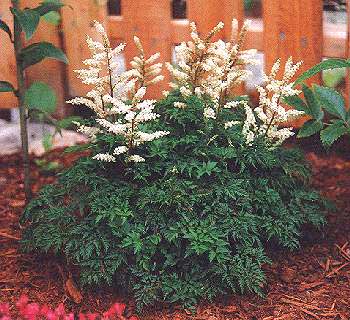Aruncus aethusifolius
DWARF GOAT'S BEARD
Family: Rosaceae
Pronounced: a-RUN-kus
Quick Jumps
Growing Guide
Rainy Side Notes
GROWING GUIDE

Geographical origin:
Korea.
Plant group:
Perennial.
Hardiness:
Sunset zones: 1-9,14-17.
USDA zones: 3-9.
Heat zones: 9-3.
Mature size:
Height: 10-16 inches (25-40 cm).
Width: 10-16 inches (25-40 cm).
Flowering period:
Early to midsummer.
Flowering attributes:
Plumes of creamy-white flowers very similar looking to Astilbe.
Leaf attributes:
Fern-like, deeply cut leaves. Leaves turn a rich rustic-red in autumn if growing in full sun.
Growth habit:
Clump forming perennial.
Light:
Full sun, partial to full shade.
Soil:
Fertile, humus rich, moist soil
Feeding:
Side dress with compost or leafmold annually, or mulch with shredded bark.
Propagation methods:
Sow seed in fall or spring, keep at 24-39ºF (-4 to +4ºC) for 4-8 weeks, then move to temperatures at 64-71ºF (18-22ºC) until germination. | Division fall or early spring.
Pruning methods:
None needed.
Pests or Diseases:
None; even slugs turn their noses up at Aruncus.
Rainy Side Notes
Aruncus aethusifolius is an effortless perennial to grow. Their dwarf stature and delicate, fern-like foliage makes them suitable for the front of the border, yet they look perfectly at home in a moist woodland setting. The ivory flower plumes of aruncus are comparable to an astilbe’s plumes, and both plants look good as understory plants for tall-canopied trees, nestled in beside hostas and epimediums. If you do not deadhead the plants, the seed heads add winter interest.
Aruncus does well in our mild maritime climate in the Pacific Northwest. Here we can appreciate them in the full sun garden, or in the shaded woodland garden.
Like Astilbe, it needs a lot of moisture during the growing season; do not let the soil dry out. If growing in full sun, the foliage turns a rusty-red color before it dies back to the ground.
Locate the plants where you can view them back lit by the sun. Aruncus is an excellent forage plant for bees.
Photographed in author's garden.

Gardening for the Homebrewer: Grow and Process Plants for Making Beer, Wine, Gruit, Cider, Perry, and More
By co-authors Debbie Teashon (Rainy Side Gardeners) and Wendy Tweton
Copyright Notice | Home | Search | Perennials

